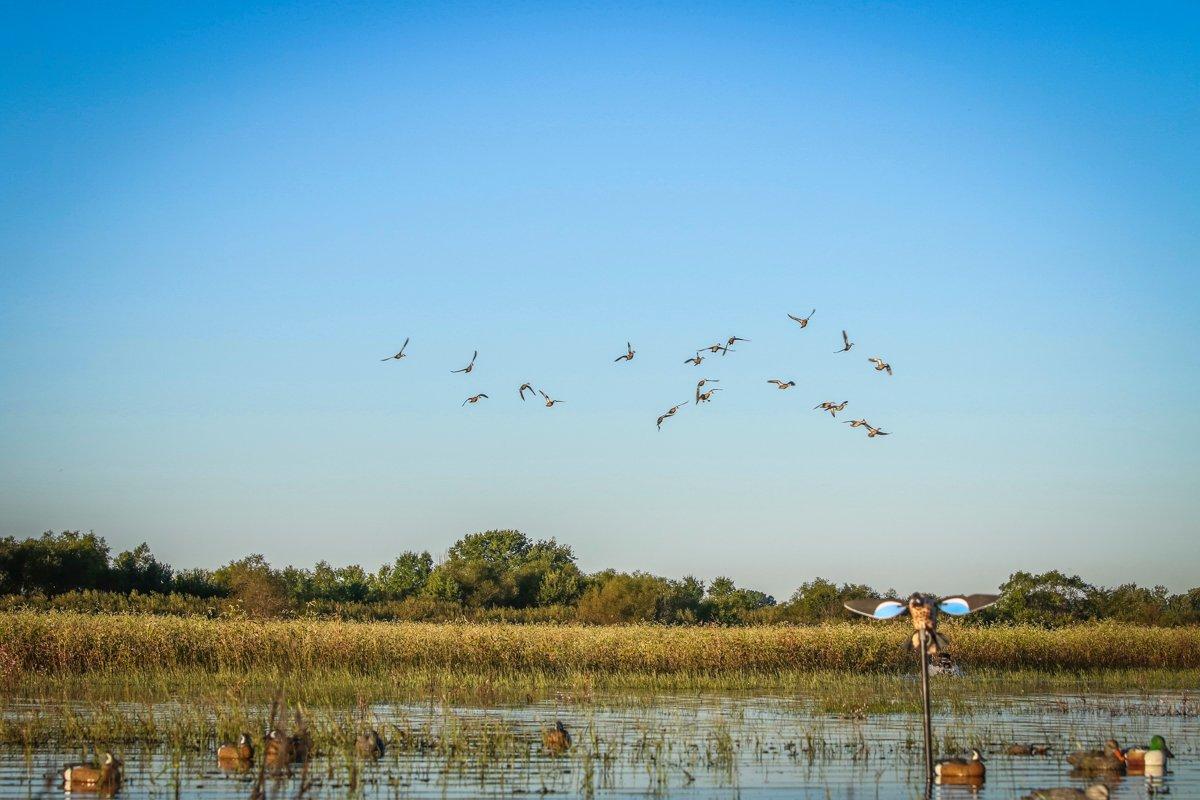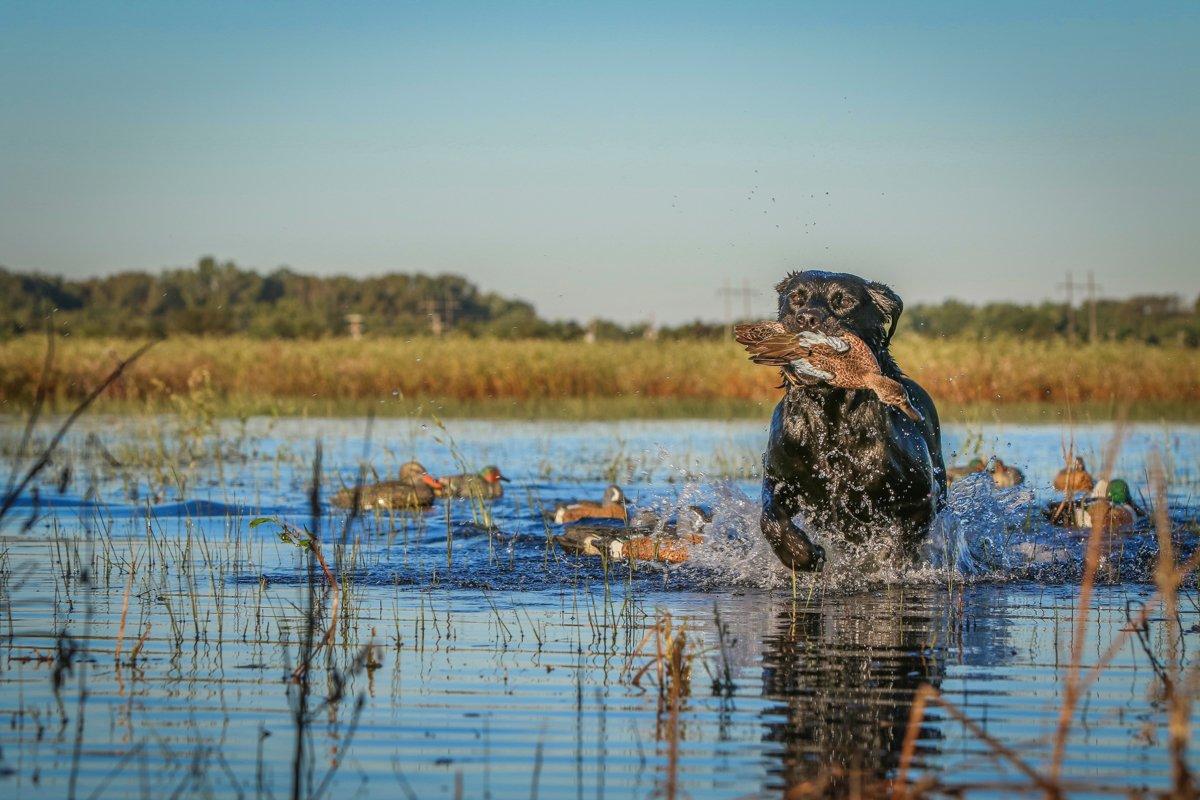Special early seasons offer tremendous opportunity for these tasty little ducks
My stepson, Adrian, and I were hunting a small eastern Iowa marsh on the opening day of the state's traditional five-day September any-duck season. The marsh was crowded but grew quiet soon after legal shooting time as the knots of homegrown mallards and squealing summer ducks headed for sanctuary. Chaos turned to nothing and the skies emptied, leaving us with one drake wood duck for our efforts.
My Mickey Mouse watch struck 11:30 a.m., and I told the boy we'd head out in 30 minutes. About that time, though, the wind shifted out of the northwest, picking up steam along with a heavy blanket of billowy gray and white clouds. And the temperature, as the boy noted, dropped; not dramatically, but noticeably. That was not unusual, for it was Iowa in September.
The sound struck me first; odd, like the air around us was being torn. Fighter jets, Adrian would tell me later; like a thousand little fighter jets. Looking up, I noticed dots, as if someone had thrown a handful of pepper into the sky and it was falling back to earth. Quickly — very quickly. Expletive, was how the boy put it, as the first flock of bluewings hit the top of the cattails and careened south at Mach I. Maybe Mach II.
Gunfire crackled along the length of the marsh. Then another flock — bigger this time — dropped from the heavens. And another. They flew for a quarter-mile, and then turned and ran the gauntlet again, each time picking up more of their migrating kin. Adrian, a new waterfowler, was beside himself. Shoot. Miss. Shoot twice. Kill one. Miss Jet, the black dog, was running and swimming raggedly to keep up, never skipping a bird. Light 'em up, the boy hollered, calling his shots and mine.
And then it was finished. Eleven fat bluewings and the single drake wood duck lay atop a muskrat house at the edge of the marsh. Miss Jet stood belly deep in the duckweed, tongue hanging, eyes ready.
I'd missed a few, the boy told me, as he slid half the birds into his game pouch. You missed a bunch, I said, correcting him, adding that we'd see how many bullets he had left and analyze his hit-to-miss ratio.
Yeah, he said sheepishly, we ought not do that.
I grinned. We'd had front-row seats to one of the greatest outdoor spectacles to which a waterfowler might be privy: a massive teal migration when everything fell into place, the proverbial stars aligned and, somehow, we'd packed enough ammunition.
Bluewing Winds
September teal seasons are mostly a Central, Mississippi and, to a lesser extent, Atlantic Flyway phenomenon. Teal hunting, timing and weather are synonymous. No feathered critter, save for mourning doves, seems as flighty as teal, especially bluewings. With a dip in temperature and a bit of a north-by-northwest breeze, marshes that teemed with birds on Tuesday become a vacuum Wednesday.
I'm really focused on the weather up North when it comes to September and teal, said Tony Vandemore, who is part owner of Habitat Flats, a Missouri-based waterfowling destination with branches in Arkansas and Saskatchewan. When I'm seeing temperatures in the 40s or low 50s in the Dakotas, I know it's time to get ready.
You'll occasionally find bluewings on a meandering river system or larger body of open water, but ideal teal habitat consists mostly of shallow wetlands; waters ringed with cattails and filled with choice foods such as duckweed, milfoil and small creepy-crawlers. If you find something like that in September, you'll likely get into birds, given the right weather.
Decoys
Can decoys make a difference when it comes to teal? Yes. Are fakes necessary if you're in the right spot at the right time? No. But they can make it more fun. Teal decoys are diminutive, though, and get lost easily among September's smartweed, cattails, lily pads and similar greenery.
I may throw out a handful of teal decoys, Vandemore said, but more likely it's mallards or other bigger ducks. I like drake shovelers in the mix. The white really shows up.

Teal like to sit close on the water, often feather-to-feather in little clusters or groups, Vandemore said. I might grab six or eight Texas rigs and throw 'em out all together. They're touching and close.
What about spinners?
They can't hurt, Vandemore said. But I don't use anything too big or too gaudy. Smaller teal or high-RPM dove or pigeon spinners work well.
Calls and Calling
Teal have their own vocabulary and can be very vocal.
Calling can make a difference, Vandemore said. A little something. Some broken, choppy sounds.
A talented caller, Vandemore uses his natural voice during September. I often use teal-specific calls. Duck Commander and Haydel's both make good ones. I'm also partial to a single-reed mallard choked down tight to achieve the higher pitches and quick cadences produced by teal.
Shells and Shooting
Small pellets are the way to go for teal ammo. They're not hard to knock down, but you need to hit them.
They're a small target, Vandemore said. I'm looking for something with pattern density. You don't need anything big.
He uses 2-3/4-inch shells, usually in 20-gauge, with No. 6 or 7 steel. Federal makes a dandy 20-gauge Speed-Shok load with ¾ ounce of No. 7 steel.
Teal and the Table
Of all the puddle duck species I've eaten over the past 45 years, teal and wood ducks stand out. For Vandemore's dollar, give him his version of the tried-and-true Philly steak.
Slice those teal breasts into thin strips, and coat 'em with a little olive oil, he said. In one pan, you're sautéing peppers, mushrooms and onions. In the other, flash-fry the teal strips. Serve 'em up on a hoagie bun smothered with cheese and a little of Abbie's (camp cook and gourmet chef Mike Abbadessa) sauce, and man alive.
Several years ago, I stumbled on a great recipe during an afternoon fish fry. I had several bluewings plucked whole. Looking at the bubbling peanut oil, I was inspired. I stuffed each bird with diced apples, sweet onions and peel-on oranges, wrapped them in fat bacon, secured each with a toothpick, and dropped them two by two into the grease, where they stayed for seven minutes. Let's say the catfish came in a distant second.
Teal Appeal
It's hot. It's humid. And the mosquitoes are often terrible. Are these challenges worth it for a half-dozen of one of North America's smallest puddle ducks? Absolutely.
Click here for more Realtree waterfowl hunting content. And check us out on Facebook.








